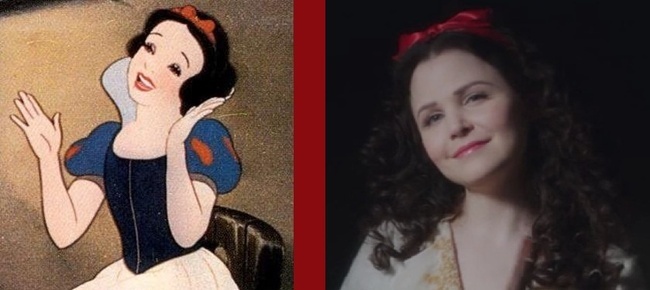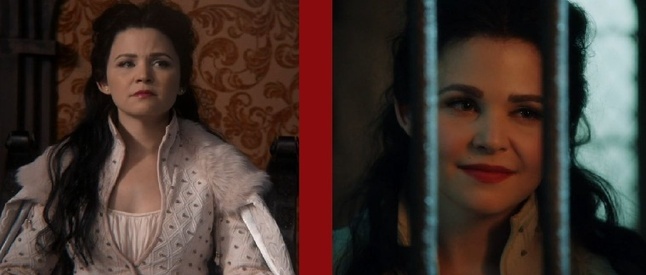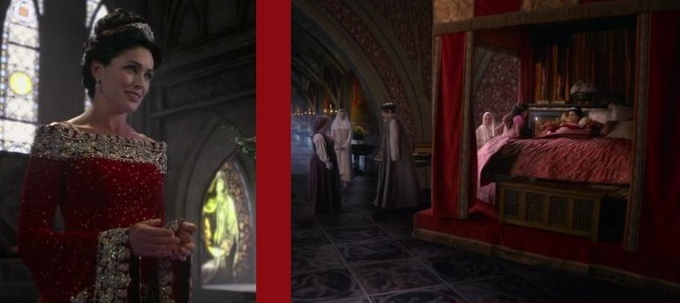|
By Zachery Van Norman - @TheZachVan Snow White is easily one of the most famous fairy tale characters in existence and a tale in which color plays a central role. The common variant of the story, brought to us by the Brothers Grimm, begins with a queen sewing by a windowsill during winter. She pricks her finger and blood falls on the snow upon the wood frame; admiring the colors, the queen wishes for a child with skin white as snow, hair black as ebony, and lips red as blood. The queen's desire is the first indication that the color red is of vital importance to the story, and she later gives birth to a daughter of desired description before dying shortly thereafter. The king marries another but also dies, and the new queen becomes jealous of Snow White's emerging beauty and plots for her huntsman to kill the princess. She demands Snow's red heart as proof of her death; the girl escapes to a cottage of seven dwarfs and is eventually poisoned by the queen's red apple, dooming her to a cursed sleep before a princely escort awakens her. As my friend Woodrow Martin explains in her article “Mix & Match,” this version of the tale changes the role of the queen, for she was originally Snow White's mother and not the stepmother. The Snow White story has other alterations in different versions throughout the world: another Grimm telling has a count and countess riding past mounds of white snow, ditches full of red blood and a flock of black ravens before finding a girl of matching hue description. The Italian version changes the queen's proof of Snow's death from her heart to her blood-soaked shirt, while the Spanish adaptation has the queen demanding a bottle of Snow's blood corked with the girl's own toe. While the story varies from region to region, the common vein of blood runs throughout. Of course no discussion of Snow White is complete without mentioning the famous 1937 Disney film Snow White and the Seven Dwarfs. This Snow White begins as a scullery maid, but her clothes later include a nod to the three colors in the common version of the fairy tale: her hair is black and tied with a red ribbon, she has “lips red as the rose,” and while her skin is not the color of snow, she wears a white collar around her neck. Her sleeves also have red accents, as if to emphasize her physical strength while toiling as a scullery maid; the ribbon in her hair could be interpreted as a simple crown for a simple princess, a subtle symbol for the color red's meaning of power. The metaphors continue as the film progresses: mirroring the queen of Grimm notoriety, Disney's Evil Queen is set on obtaining Snow's heart as her victory trophy, and uses a red apple to bring the princess under sleeping death. The poisoned apple, red as blood, is the ultimate symbol of the battle between the good Snow and the evil Queen. At the start of the Disney film, the Queen asks her magic mirror the famous question, “Mirror mirror on the wall, who is the fairest one of all?” Defying her expectations, the mirror reveals that Snow White is the fairest in the land, and as this event unfolds, Snow White is pursued by Prince Charming and his one song. The Queen watches the prince serenade the princess, her hatred pushed to the max as she realizes that Snow White has reached an age of maturity and will one day replace her as ruler. The Queen truly believes that beauty is power, and the mirror's news that Snow is more attractive is a death sentence to her days as monarch; she now seeks to destroy Snow White as a result of jealousy, an envious craze of Snow's beauty and grace. Snow's pitch-perfect singing and “lips red as the rose” emphasize her impending role as the voice of reason in the kingdom, and the apple is the Queen's way of silencing that voice to ensure her own insane rule. Snow is unable to resist the temptation of the apple and takes a bite, falling into the sleeping death. The Queen is pursued by the seven dwarves, losing her life in a moment of madness, and Charming's kiss awakens the poisoned princess before the two of them ride off to live happily ever after. Where One Ends, Another Begins As mentioned in the previous article, it is this kiss that also begins Once Upon A Time, but in contrast to the animated princess, the Once Snow White embodied by Ginnifer Goodwin doesn't wear blue, yellow or red. In fact, there has been only one occasion when Snow wears any of her cartoon counterpart's favored colors: the episode “Heart of Darkness,” when Snow wears a yellow dress and a red ribbon in her hair. During her intervention, Snow expresses anger at living her life as an outlaw with the dwarves rather than as a princess with her father, harkening back to the ribbon's importance as a substitute for a crown. Apart from this one example, the OUAT Snow wears variations of white, an obvious choice for one so named, but also a nod to her pure heart. Snow's capacity for love is also the driving force behind her pursuit of a peaceful solution in the face of any problem. Her diplomatic skills are even noted by Charming in “We Are Both,” when he tells Henry that he used to do all the fighting, and 'Snow used to do all the talking.' This applied to Regina in “The Cricket Game,” when Snow tried to talk her to give up her evil ways. It is hardly surprising that her red lips would be the tool through which Snow White wields her power as ruler. Snow has no power in her cursed state as Mary Margaret, yet the color red is prevalent in her life daily. While the décor of her loft is predominately white, she has an accent wall of red brick, with the words 'paste,' grate,' and 'polish' painted upon it. These are the same words that the Evil Queen would have given the scullery maid Snow White in the animated feature, a subtle reference to the one that started it all. In this situation, red is used to display Regina's powerful victory with the curse, and the inclusion of the word 'blackbird' completes the color triad of red, white and black; it could also be interpreted as a nod to Snow's connection to birds. Mary Margaret's wardrobe is quite similar to Snow's in that she is almost always wearing something white, beginning with the pilot. Other colors make appearances, but not red. She finally wears the shade in “7:15 AM,” during the conversation where she acknowledges her true feelings for David (an admission made verbally, I might add.) This is a highly appropriate color for a conversation about her true love and matters of the heart. Mary Margaret doesn't wear red again until “The Cricket Game,” when she and Emma arrive at their welcome home party at Granny's after portal-jumping to the Enchanted Forest. Mary Margaret is wearing red from top to bottom, right down to her shoes. While Happy wears a jacket that looks similar, only Mary Margaret wears red; not even Ruby has her signature color on. This is the moment when Snow White has returned home in power, restored as leader of her people and matriarch of her family. Snow’s leadership abilities are no doubt inherited from her mother, Queen Eva, played by Rena Sofer in “The Queen Is Dead.” Eva clearly favors red, as evidenced by her gorgeous gown and the bed curtains and tapestries in her bedchamber. This preference represents the strength of character displayed when she reprimands a young Snow White for her rude behavior towards her maid Johanna. Hers is a powerful presence, one strong enough to command respect yet soft enough to inspire goodness in others. Eva is fatally poisoned by Cora (Barbara Hershey), who disguises herself as the Blue Fairy and offers Snow a magic candle that will save Eva’s life if lit, but Snow must hold the candle over the heart of another and take their life to save her mother’s. Snow lives up to her mother’s teachings and cannot bring herself to do it; Eva dies, but Snow seems to have honored her mother’s memory by giving her own daughter the near-matching name of Emma. Meanwhile Snow is able to reunite with Johanna at her home in Storybrooke, after Johanna left Snow her mother’s tiara as a birthday present; Johanna calls Snow by her given name, but Snow says that her name is Mary Margaret. Their reunion is short-lived: Johanna is killed later that day when Cora uses magic to throw her out of the clock tower. As Snow and Charming lay Johanna to rest, Snow declares her intention to kill Cora, both as revenge for everything she’d lost to Cora and Regina as well as to prevent Cora from hurting anyone else. It is notable that the episode where the pure Snow White refers to herself by a different name is the same episode in which she chooses a path of darkness, a path completely contradictory to her nature. By calling herself another name, Snow White herself offers the proof that she is unsure of who she is now. Her determination to kill Cora, itself a sign of her lost path, reaches a turning point when a dying Rumplestiltskin offers her a method to achieve her goal: the same candle from her past, which will swap Cora’s life for his own. The candle, like the poisoned apple, proves too strong a temptation for Snow White. She enters Regina’s family mausoleum and lights the candle over Cora’s heart, beginning the spell that will take her life. It is notable that the candle is black and white with a red stone, for these are the same colors that are the heart of Snow White’s very existence. In another use of color as symbolism, her actions demonstrate that evil is not always black and white, and that acts of darkness affect the core of who we are. This is shown literally when a deeply depressed Snow White goes to Regina’s house in a suicidal attempt to end her misery in “Welcome to Storybrooke.” Regina takes Snow’s apple-like heart, revealing the seed of evil planted within, but returns it to its place in order to make her suffer. Snow was left desperate to scrub the evil from her heart. After Greg and Tamara activated Regina’s trigger to destroy Storybrooke, Snow went with her family to the mines and told Regina that they would work together to stop it. Emma and Regina stopped the destruction, but at the expense of Henry’s kidnapping to Neverland by Greg and Tamara. United as a family, the Charmings boarded the Jolly Roger to rescue Henry with Captain Hook, but there will no doubt be new dangers as Snow White travels with the two people who want to destroy her the most: the daughter of the woman she killed, and the man who gave her the weapon to do so.
0 Comments
Leave a Reply. |
OriginsExplore the Arthurian legend surrounding Lancelot, take a trip into the woods to discover the mythology behind Red Riding Hood or learn more about a modern day hero called Snow White. Origins provides unique insights and perspectives from talented writers into the characters we know and love, going far beyond the boundaries of Storybrooke. Archives
August 2016
Categories
All
|











